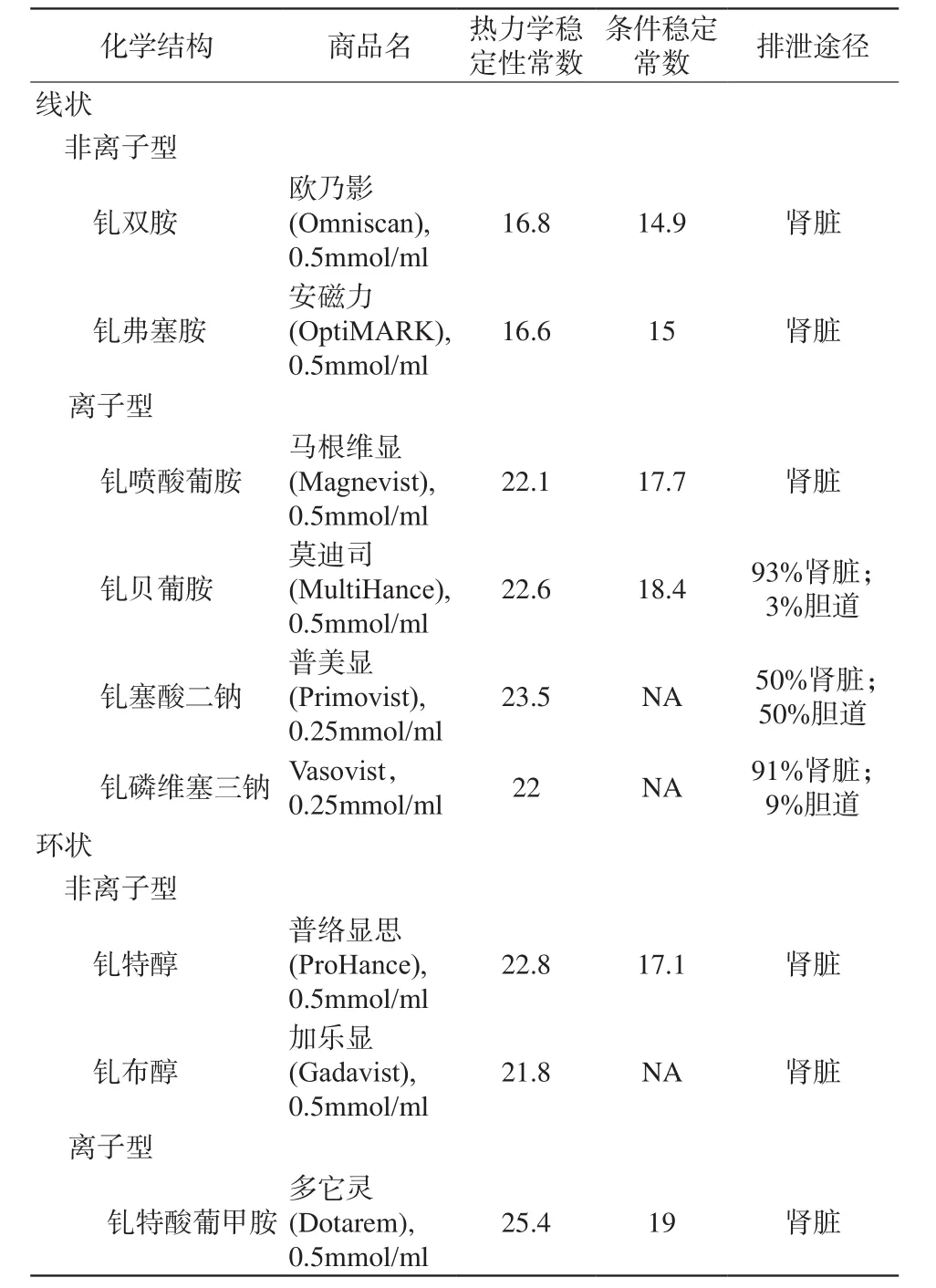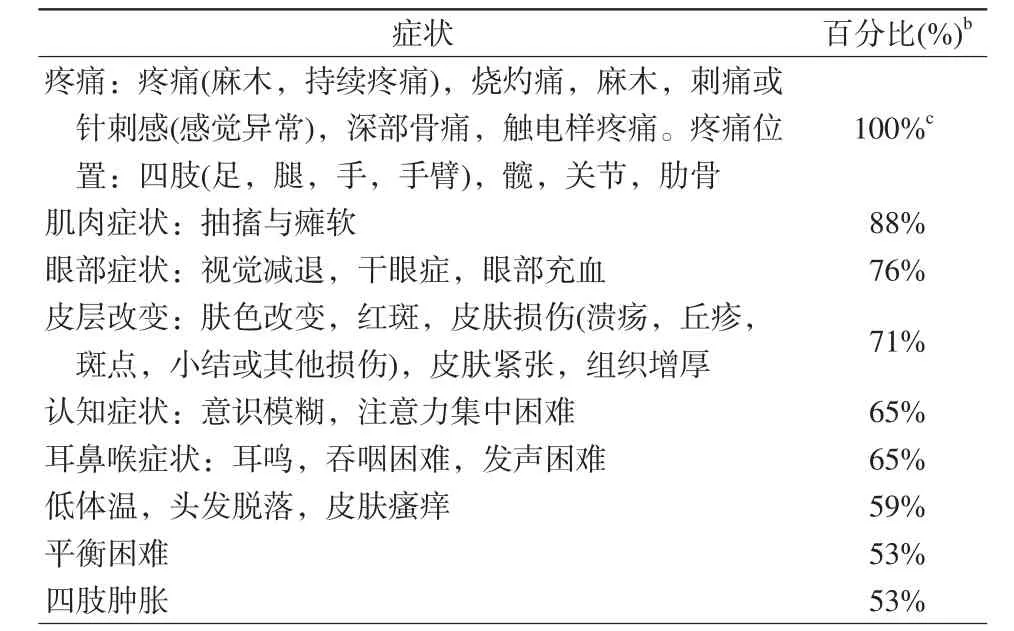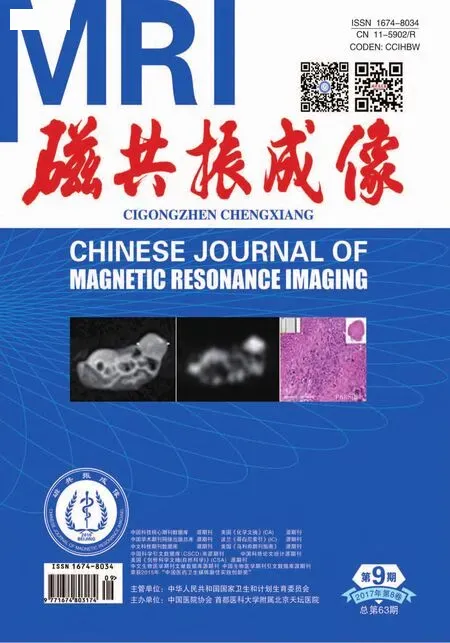磁共振钆对比剂体内分布与沉积研究现状
刘哲,程燕南,杨健
磁共振增强检查因钆对比剂高弛豫率的特点,通过静脉注射可以突出显示病灶的形态,在临床疾病的诊断及鉴别诊断中广泛应用。在美国,每年有超过1000万患者进行磁共振增强检查,占全部磁共振检查的40%~50%[1],被认为是非常安全的检查方法之一。自从2006年有报道提出肾功能损伤患者注射钆对比剂和NSF密切相关以来[2-3],磁共振钆对比剂的安全应用一再引起重视,尤其是近些年报道的肾功能正常患者多次注射钆对比剂会引起颅内钆沉积现象,更是得到了美国食品和药物管理局(Food and Drug Administration,FDA)的关注(http://www. fda. gov/downloads/Drugs/DrugSafety/UCM455390. pdf, 2015.),但目前钆沉积的可能的机制及临床意义尚不清楚。因此,笔者回顾国内外关于磁共振钆对比剂应用的文献,总结其不同分类及危险等级、体内分布与沉积现状、可能的发生机制及临床意义等,为临床钆对比剂的选择应用提供有力的帮助。
1 磁共振钆对比剂的分类及危险等级
目前通过美国FDA认证的钆对比剂主要有9种,根据其化学结构及电荷量可分为线状、环状、离子型及非离子型(表1)[4];根据分子的动力学和热力学作用,钆离子和其配体在溶液中解离处于动态平衡状态,不同类型对比剂热稳定性不同,因此释放钆离子的能力也不尽相同。2008年Frenzel等[5]报道了注射不同钆对比剂15 d后血清(pH 7.4,37 ℃)中的稳定性,钆弗塞胺和钆双胺约有20%的钆释放,离子线型有小于2%的钆释放,环状对比剂没有检测到钆释放,同时,2017年有学者最新提出在儿童多次静脉注射环状对比剂不会引起齿状核T1信号增高[6]。因此钆对比剂的稳定性由高至低排序如下:环状对比剂>离子线型对比剂>非离子线型对比剂[7]。因为钆离子在体内具有毒性,解离度越大的对比剂危险性越高,尤其是肾功能异常患者,体内长时间存留的钆离子更易促进肾源性系统性纤维化(nephrogenic systemic fibrosis, NSF)的发生。欧洲用药委员会(CHMP)根据磁共振对比剂造成NSF的危险性,将其分为高危、中危和低危三级(表2)[8],不同钆对比剂的危险等级为临床医生安全性用药提供了有力的参考。
2 钆对比剂解离的机制
钆对比剂解离的机制主要有金属置换反应、血清pH值和炎性机制(氧化应激、细胞凋亡)等。高亲和力的Zn2+、Cu2+、Fe3+、Ca2+等和钆的配位键结合,或钆和磷酸盐及碳酸盐相结合引起置换反应,促进钆螯合物的解离,使体内钆离子增加[9]。另外一个释放钆离子的机制可能是血清pH值,pH值越低,钆螯合物越不稳定,钆离子越容易被释放。因此,血清内游离钆越多,体内钆沉积现象越容易发生[9]。

表1 目前已被证实的临床使用的钆对比剂[4]Tab. 1 Gadolinium-based contrast agents currently approved for clinical use: biochemical properties[4]

表2 欧洲用药委员会发布磁共振钆对比剂的危险等级[8]Tab. 2 CHMP: risk level of Gadolinium-based contrast agents[8]
3 磁共振钆对比剂的体内分布与沉积
磁共振钆对比剂注射途径是影响其体内生物学分布和安全性的主要因素[9],临床主要为静脉注射,非特异性对比剂存在于循环血液及细胞外间隙,特异性对比剂可被靶器官摄取,最终通过泌尿系统或胆道排出体外。
3.1 钆对比剂与NSF
钆对比剂可以刺激组织和器官发生纤维化[10],尤其是肾功能不全以及一些近期有重大手术、血管介入、血栓形成、全身炎症等患者[11-12],长期存留的钆离子可以引起血浆中的纤维细胞数量增高,两者在血浆中进行反应,容易引起NSF。NSF主要影响心脏、肾脏及皮肤等部位,尤其是皮肤最为明显,其病理变化主要以组织增厚、硬化、皮肤紧缩、皮下水肿等为主,几天或几个月后形成[13],其中NSF患者皮肤活检中可明显发现钆成分[14-18];因此,钆在皮肤内的沉积和NSF密切相关。
3.2 钆对比剂骨内沉积
钆对比剂骨内沉积是个旧话题,早在2004年就有人发现不同钆对比剂在骨内沉积量不尽相同[17]。其中钆双胺引起骨内沉积是钆特醇的2.5~4.0倍[9,19],线型对比剂中约1%~2%的注射计量可在骨内长期沉积[9]。2006年White等[20]利用电感耦合等离子质谱法(inductively coupled plasma mass spectrometry,ICP-MS)分析注射钆对比剂后髋关节置换的肾功能正常患者,发现其股骨内明显存在钆离子成分。2009年Darrah等[21]分析股骨头标本后再次证实注射线性对比剂更易引起骨钆沉积,骨小梁钆沉积量明显多于骨皮质,且可沉积长达8年之久。因此,骨是钆沉积的主要靶器官之一[9],而且在众多对比剂中,前24 h各种对比剂生物学分布相似,约7~14 d各种对比剂体内分布将发生差异[9]。
3.3 钆对比剂脑内沉积
3.3.1 颅内苍白球T1高信号与顺磁性物质
钆和锰均属于顺磁性物质,有文献报道多次静脉注射钆对比剂或含锰物质均可以引起颅内苍白球T1信号增高[22-26]。其中顺磁性物质锰(Mn)在苍白球内沉积现象早在1983年就有学者提出[23],尤其是长期静脉注射含锰营养药物的患者,颅内苍白球信号T1明显增高[24-25],并且其信号增高程度和锰的剂量密切相关[23-26]。然而钆对比剂引起苍白球T1信号增高的现象则是近几年新发现的热点,不仅是苍白球,齿状核、丘脑、黑质、红核、小脑脚等部位均可发现T1高信号改变[27]。因为钆对比剂是目前磁共振增强检查最常用的方法之一,且钆离子具有强毒性,其安全性一直是一个热点话题,钆对比剂颅内沉积是否会引起相应的不良反应引起了广泛的关注。
3.3.2 钆对比剂脑内沉积研究现状
2014年Kanda等[22]首次提出多次(≥6次)注射钆对比剂前后苍白球/丘脑与齿状核/桥脑T1WI平扫信号比有明显差异,并且其T1信号增高程度与增强扫描次数呈明显线性增加关系[28],脑钆沉积的量与钆对比剂剂量呈依赖关系,与肾功能、年龄、扫描间隔等无明显相关性[29]。随后又有大量研究显示苍白球及齿状核钆沉积量与钆对比剂种类密切相关,众多研究一致认为非离子线型对比剂更易发生颅内钆沉积现象,线型离子型次之,环状对比剂相对少见[30-34],此现象和钆对比剂解离程度及其危险等级相一致。其中,虽然环状对比剂安全性相对较高,但Stojanov等[35]发现系统性硬化患者多次注射环状对比剂后也可引起齿状核信号轻微改变。因此,所有钆对比剂均可引起颅内钆沉积现象,线状对比剂尤为明显。
2015年Kanda等[36]和McDonald等[29]利用ICPMS方法对尸体脑组织进行研究发现生前注射线状钆对比剂患者脑内苍白球和齿状核钆含量明显增高。McDonald等[29]又利用透射电子显微镜和电子探针显微镜进一步证实了颅内苍白球及齿状核存在钆沉积现象。同期FDA正式提出多次注射钆对比剂与脑内钆沉积密切相关,可能对人体造成的危险,应该引起广大医师的重视[37]。为避免钆对比剂给患者带来危害,FDA建议肾功能不全者,孕妇和儿童尽量避免使用钆对比剂或采用最低剂量以达到临床诊断为目的,同时欧洲药品管理局(European Medicines Agency,EMA)也指出可实施个人钆对比剂使用卡制度,明确个体化监测,全面评估利弊后合理使用[38]。
钆对比剂的颅内沉积的具体机制至今尚不清楚,有学者提出金属进入神经系统可能存在以下三种机制:载体介导机制、转运体介导机制和被动运输[39],但钆离子通过血脑屏障并沉积在颅内特殊部位的机制仍需进一步研究。
3.4 钆对比剂在体内其他部位的分布与沉积
钆对比剂除了在皮肤、骨组织、脑内分布沉积以外,在肾脏、心脏、肺组织、肝脏、淋巴结等多部位均有沉积现象,且沉积点多位于血管或胞内钙化处[40],但其具体沉积机制及沉积形式目前仍不清楚,需要更多的学者进一步的研究。
4 钆对比剂体内分布与沉积的临床意义
Paracelsus提出所有物质均具有毒性,只有合理的剂量才不会使物质表现出其毒性作用[10]。钆螯合物在体内容易被耐受[41],标准剂量下应用被认为是相对安全的[10],但之前又有大量文献报道了钆对比剂的危险因素,认为不同种类对比剂体内沉积量不一致,且有调查显示了所有有症状的患者中存在着不同的临床表现(表3)[4]。由此可以推测钆对比剂过量应用可能是造成不良反应的危险因素之一,但仍需更多文献进行支持。其中,钆对比剂在脑内的沉积仍处于探索阶段,近几年研究发现的脑内钆沉积部位和过去脑内锰沉积部位一致,不同顺磁性金属物质是否均可沉积在脑内深部核团,其毒性大小等问题则需要更多的研究来证实。
总而言之,钆对比剂可在体内多器官脏器沉积,并且其体内分布、沉积与钆对比剂的种类及静脉注射剂量密切相关,其安全性一直被关注。在未来的研究中,我们需要更进一步的探索顺磁性钆对比剂脑内沉积的机制、可能的神经不良反应以及其安全性用药原则等问题,为临床提供更多的帮助。

表3 MR增强扫描钆组织沉积引起不同部位慢性症状调查汇总a[4]Tab. 3 Summary of the results of the "Survey of Chronic Effects of Retained Gadolinium from Contrast MRIs"a[4]
[References]
[1] Zhou Z, Lu ZR. Gadolinium-based contrast agents for magnetic resonance cancer imaging. Wires Nanomed Nanobi, 2013, 5(1): 1-18.
[2] Grobner T. Gadolinium-a specific trigger for the development of nephrogenic fibrosing dermopathy and nephrogenic systemicfibrosis? Nephrol Dial Transpl, 2006, 21(4): 1104-1108.
[3] Marckmann P, Skov L, Rossen K, et al. Nephrogenic systemicfibrosis: suspected causative role of gadodiamide used for contrastenhanced magnetic resonance imaging. J Am Soc Nephrol, 2006,17(9): 2359-2362.
[4] Ramalho J, Semelka RC, Ramalho M, et al. Gadolinium-based contrast agent accumulation and toxicity: an update. Am J Neuroradiol, 2016, 37(7): 1192-1198.
[5] Frenzel T, Lengsfeld P, Schirmer H, et al. Stability of gadoliniumbased magnetic resonance imaging contrast agents in human serum at 37 C. Invest Radiol, 2008, 43(12): 817-828.
[6] Weberling LD, Kieslich PJ, Kickingereder P, et al. Increased signal intensity in the dentate nucleus on unenhanced T1-weighted images after gadobenate dimeglumine administration. Invest Radiol, 2015,50(11): 743-748.
[7] Bhargava R, Hahn G, Hirsch W, et al. Contrast-enhanced magnetic resonance imaging in pediatric patients: review and recommendations for current practice. Magn Reson Insights, 2013, 20(6): 95-111.
[8] Thomsen HS, Morcos SK, Almén T, et al. Nephrogenic systemic fibrosis and gadolinium-based contrast media: updated ESUR Contrast Medium Safety Committee guidelines. Eur Radiol, 2013,23(2): 307-318.
[9] Aime S, Caravan P. Biodistribution of gadolinium‐based contrast agents, including gadolinium deposition. J Magn Reson Imaging,2009, 30(6): 1259-1267.
[10] Lin SP, Brown JJ. MR contrast agents: physical and pharmacologic basics. J Magn Reson Imaging, 2007, 25(5): 884-899.
[11] Sadowski EA, Bennett LK, Chan MR, et al. Nephrogenic systemic fibrosis: risk factors and incidence estimation. Radiology, 2007,243(1): 148-157.
[12] Mendichovszky IA, Marks SD, Simcock CM, et al. Gadolinium and nephrogenic systemic fibrosis: time to tighten practice. Pediatr Radiol, 2008, 38(5): 489-496.
[13] Gibson SE, Farver CF, Prayson RA. Multiorgan involvement in nephrogenic fibrosing dermopathy: an autopsy case and review of the literature. Arch Pathol Lab Med, 2006, 130(2): 209-212.
[14] Kay J, Bazari H, Avery LL, et al. Case 6-2008: a 46-year-old woman with renal failure and stiffness of the joints and skin. New Engl J Med, 2008, 358(8): 827-838.
[15] Swaminathan S, High WA, Ranville J, et al. Cardiac and vascular metal deposition with high mortality in nephrogenic systemicfibrosis. Kidney Int, 2008, 73(12): 1413-1418.
[16] Singh M, Davenport A, Clatworthy I, et al. A follow‐up of four cases of nephrogenic systemic fibrosis: is gadolinium the specific trigger? Brit J Dermatol, 2008, 158(6): 1358-1362.
[17] Wiginton CD, Kelly B, Oto A, et al. Gadolinium-based contrast exposure, nephrogenic systemic fibrosis, and gadolinium detection in tissue. Am J Roentgenol, 2008, 190(4): 1060-1068.
[18] Abraham JL, Thakral C, Skov L, et al. Dermal inorganic gadolinium concentrations: evidence for in vivo transmetallation and long-term persistence in nephrogenic systemic fibrosis. Brit J Dermatol, 2008,158(2): 273-280.
[19] Gibby WA, Gibby KA, Gibby WA. Comparison of Gd DTPABMA (Omniscan) versus Gd HP-DO3A (ProHance) retention in human bone tissue by inductively coupled plasma atomic emission spectroscopy. Invest Radiol, 2004, 39(3): 138-142.
[20] White GW, Gibby WA, Tweedle MF. Comparison of Gd (DTPABMA) (Omniscan) versus Gd (HP-DO3A) (ProHance) relative to gadolinium retention in human bone tissue by inductively coupled plasma mass spectroscopy. Invest Radiol, 2006, 41(3): 272-278.
[21] Darrah TH, Prutsman-Pfeiffer JJ, Poreda RJ, et al. Incorporation of excess gadolinium into human bone from medical contrast agents.Metallomics, 2009, 1(6): 479-488.
[22] Kanda T, Ishii K, Kawaguchi H, et al. High signal intensity in the dentate nucleus and globus pallidus on unenhanced T1-weighted MR images: relationship with increasing cumulative dose of a gadolinium-based contrast material. Radiology, 2013, 270(3): 834-841.
[23] Bird ED, Anton AH, Bullock B. The effect of manganese inhalation on basal ganglia dopamine concentrations in rhesus monkey.Neurotoxicology, 1983, 5(1): 59-65.
[24] Newland MC, Ceckler TL, Kordower JH, et al. Visualizing manganese in the primate basal ganglia with magnetic resonance imaging. Exp Neurol, 1989, 106(3): 251-258.
[25] Mirowitz SA, Westrich TJ, Hirsch JD. Hyperintense basal ganglia on T1-weighted MR images in patients receiving parenteral nutrition.Radiology, 1991, 181(1): 117-120.
[26] Shin YC, Kim E, Cheong HK, et al. High signal intensity on magnetic resonance imaging as a predictor of neurobehavioral performance of workers exposed to manganese. Neurotoxicology, 2007, 28(2): 257-262.
[27] Zhang Y, Cao Y, Shih GL, et al. Extent of signal hyperintensity on unenhanced T1-weighted brain MR images after more than 35 administrations of linear gadolinium-based contrast agents.Radiology, 2017, 282(2): 516-525.
[28] Errante Y, Cirimele V, Mallio CA, et al. Progressive increase of T1 signal intensity of the dentate nucleus on unenhanced magnetic resonance images is associated with cumulative doses of intravenously administered gadodiamide in patients with normal renal function,suggesting dechelation. Invest Radiol, 2014, 49(10): 685-690.
[29] McDonald RJ, McDonald JS, Kallmes DF, et al. Intracranial gadolinium deposition after contrast-enhanced MR imaging.Radiology, 2015, 275(3): 772-782.
[30] Quattrocchi CC, Mallio CA, Errante Y, et al. Gadodiamide and dentate nucleus T1 hyperintensity in patients with meningioma evaluated by multiple follow-up contrast-enhanced magnetic resonance examinations with no systemic interval therapy. Invest Radiol, 2015, 50(7): 470-472.
[31] Kanda T, Osawa M, Oba H, et al. High signal intensity in dentate nucleus on unenhanced T1-weighted MR images: association with linear versus macrocyclic gadolinium chelate administration.Radiology, 2015, 275(3): 803-809.
[32] Ramalho J, Castillo M, AlObaidy M, et al. High signal intensity in globus pallidus and dentate nucleus on unenhanced T1-weighted MR images: evaluation of two linear gadolinium-based contrast agents.Radiology, 2015, 276(3): 836-844.
[33] Kanda T, Matsuda M, Oba H, et al. High T1 signal intensity in dentate nucleus after multiple injections of linear gadolinium chelates response. Radiology, 2015, 276(2): 617-617.
[34] Weberling LD, Kieslich PJ, Kickingereder P, et al. Increased signal intensity in the dentate nucleus on unenhanced T1-weighted images after gadobenate dimeglumine administration. Invest Radiol, 2015,50(11): 743-748.
[35] Stojanov DA, Aracki-Trenkic A, Vojinovic S, et al. Increasing signal intensity within the dentate nucleus and globus pallidus on unenhanced T1W magnetic resonance images in patients with relapsing-remitting multiple sclerosis: correlation with cumulative dose of a macrocyclic gadolinium-based contrast agent, gadobutrol.Eur Radiol, 2016, 26(3): 807-815.
[36] Kanda T, Fukusato T, Matsuda M, et al. Gadolinium-based contrast agent accumulates in the brain even in subjects without severe renal dysfunction: evaluation of autopsy brain specimens with inductively coupled plasma mass spectroscopy. Radiology, 2015, 276(1): 228-232.
[37] Zobel BB, Quattrocchi CC, Errante Y, et al. Gadolinium-based contrast agents: did we miss something in the last 25 years? Radiol Med, 2016, 121(6): 478-481.
[38] Zhu FP, Zhang LJ, Lu GM. NSF and Gadolinium-based contrast agents. Radiol Pract, 2010, 25(2): 219-221.朱飞鹏, 张龙江, 卢光明. 肾源性系统性纤维化与磁共振含钆对比剂. 放射学实践, 2010, 25(2): 219-221.
[39] Prybylski JP, Maxwell E, Sanchez CC, et al. Gadolinium deposition in the brain: lessons learned from other metals known to cross the blood-brain barrier. Magn Reson Imaging, 2016, 34(10): 1366-1372.
[40] Sanyal S, Marckmann P, Scherer S, et al. Multiorgan gadolinium(Gd) deposition and fibrosis in a patient with nephrogenic systemic fibrosis-an autopsy-based review. Nephrol Dial Transpl, 2011,26(11): 3616-3626.
[41] Hao D, Ai T, Goerner F, et al. MRI contrast agents: basic chemistry and safety. J Magn Reson Imaging, 2012, 36(5): 1060-1071.

